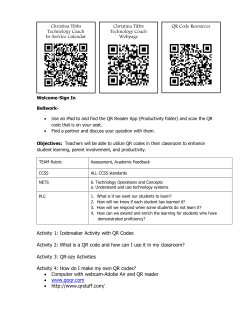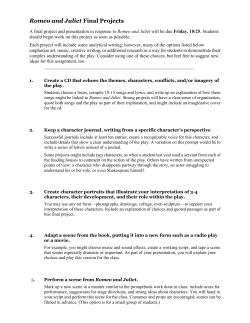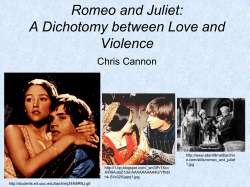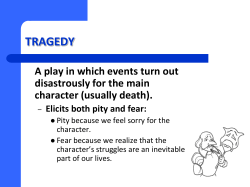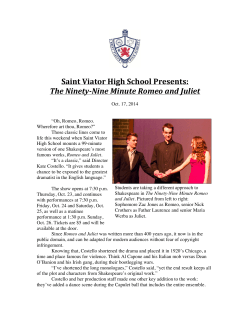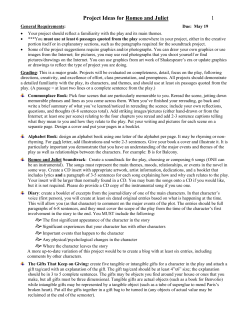
+ CCSS Implementation: Designing Significant Learning Experiences Les Bois
+ CCSS Implementation: Designing Significant Learning Experiences Les Bois March 5, 2013 Boise State Writing Project + Designing significant learning experiences using inquiry + Why Inquiry? Being told is the opposite of finding out –Jimmy Britton Correspondence Concept – student thinking matches expert thinking Engaging Relevant – motivating! Works for deep understanding AND application—transfer to new and authentic situations Allows for differentiation Meeting the Common Core State Standards Authentic collaboration (SMITH AND WILHELM, 2002; 2006) + Step 1: Select your standards Step 1: Select a rich, complex standard that could serve as the focus of a unit. Then select one or two standards from each of the strands that logically fit with your central standard. Pull those cards. These standards will serve as the foundation of your unit + Coding of the standards Type of text Grade level Strand RL.8.1 Standard number R=Reading (writing, speaking/listening, language) L=Literature (Informational, historical, science/technical) 8=8th grade 1= standard # + Step 2: Draft the inquiry question that will frame your unit Essential questions invite students into disciplinary conversations and drive their learning throughout the unit. Purpose Relevance Motivation Coherence + Characteristics of essential questions Engaging. That is, it offers potential for intriguing students and motivating student learning Enduring. That is, it leads to learning big ideas that have value beyond the classroom At the heart of a discipline. That is, it is used by practitioners to do the subject, and solve problems and create knowledge in that subject area In need of discovery. That is, it involves a background of foundational principles, rich concepts, theories and procedures that require unpacking. + Elements of good essential questions •center on major issues, problems, concerns, interests relevant to students' lives and to their communities open-ended non-judgmental meaningful and purposeful emotive force and intellectual bite invite an exploration of ideas encourage collaboration among students, teachers, and the community + Essential questions are not… Answerable through information retrieval; they require operating on information to see patterns and implications, and often requires developing new sets of data through critical inquiry on the part of students Understood Easily in one day or even one week agreed upon + Examples of good essential questions In what ways does art reflect culture as well as shape it? What are the costs and benefits of genetic engineering? Is it ever acceptable to resist an established government? What are the pros and cons of technological progress? What determines value? What makes a good relationship? What geometry concepts would be essential to build a new gymnasium, including the ordering of materials? How does our culture shape and limit our beliefs and actions? + Common problems with essential questions •Merely information retrieval; question does not require creating data or constructing new understanding •Leading •Too generic •Too narrow and specific •Not intriguing + Revising essential questions Topic: Relationships Question: Where do our marriage questions come from? (info retrieval) Revision: What makes a good relationship? Topic: Civil Rights Question: How did we win the fight for civil rights? (begs the question) Revision: What are basic human rights and how can they be secured and protected? Topic: Survival Question: Why is it bad that animals are going extinct? (leading) Revision: Who survives? Topic: Identity Question: Who am I? (generic) Revision: Where do I belong? What shapes our view of the world? +Step 2: Draft an Essential Question Which essential question is the most powerful? A) How can we be leaders? B) What makes a great leader? C) Was President Lincoln a good leader? +Step 2: Draft an Essential Question Which essential question is the most powerful? A) What is a story? B) How do stories change us? C) What makes a story memorable? +Step #2: Draft an Essential Question Which essential question is the most powerful? A) What needs to be changed in the world? B) Should people change the world? C) How can people change the world? +Step #2: Draft an Essential Question Which essential question is the most powerful? A) Who should have access to the American dream? B) Does everyone have an opportunity to achieve the American dream? C) What is the American dream? + Step 3: Design the performance task + Performance Task Purposes: Summative Assessment – Allow students to demonstrate (and deepen!) their understanding of concepts and processes. Create an immediate venue for application of learning. Establish a goal students are working towards throughout the unit + Step 3: Design the performance task Components of a Performance Task STIMULUS INFORMATION PROCESSING PRODUCT / PERFORMANCE Readings Video clips Research questions Essay, report, story, script Audio clips Graphs, charts, other visuals Comprehension questions Research topic/issue/ problem Simulated Internet search Speech with/without graphics, other media etc. etc. Responses to embedded constructed response questions. for etc.high school. Use 1-2 stimuli for Grade 3. Use up to 5 stimuli Emphasis on stimuli related to science history and social studies + Step 3: Design the performance task Specifics of Task Topic: Food production Product/Performance: Argument Audience: Idaho Statesman readers Purpose: Argue for or against current system of food production Speaker/Role: Concerned citizen whose future is impacted + Performance task template + Step 4: Select a frontloading activity to activate students’ prior knowledge Why frontload? Supports students in the acquisition of new content Provides motivation Builds sense of purpose Helps students make critical connections to content Activates procedural knowledge Makes material more personal and accessible Helps prepare students for what’s to come + Step 4: Select a frontloading activity to activate students’ prior knowledge KWL chart Ranking scenarios Opinionaire Quick writes Anticipation Guide List, group. label Silent discussion Etc……. + Frontloading example: See, Think, Wonder What do you See? I see girls yelling. What are you thinking? Why are they yelling at the girl in front? What are you wondering about? I wonder how the girl in front feels? Square + Frontloading example: Frayer Model 4 lines 4 sides 4 corners Parallel lines A shape with 4 sides and 4 lines SQUARE Square My bedroom wall Table top Sticky note American cheese slices Cube Ball Stop sign + Frontloading example: Opinionaire 1. The Smiths bought a new swing set for their children and put it near the back edge of their property. The Jones, who lived in the lot behind them, installed a six-foot wooden fence along the back border so they would not have to see the swingset or listen to the children. If they saw the Smiths walking in the street, however, the Jones would wave. Are the Jones good members of the community? Yes ___ No ___ Criterion: _____________________________________________________________________________________ 2. Mrs. Kravitz is concerned. Her new neighbor – name unknown – has a motorcycle and wears all black leather. He sports a beard, wears sunglasses on cloudy days as well as sunny ones and sometimes roars home at odd hours of the night. Out of concern for herself and her other neighbors, Mrs. Kravitz keeps a close eye on the motorcyclist by gazing out her window every chance she gets. Is Mrs. Kravitz a good member of her comminity? Yes ___ No ___ Criterion: _____________________________________________________________________ Opinionnaires are excellent frontloading devices because students are required to make and justify decisions regarding the inquiry. This requires activating their background beliefs and experiences. They can return to the opinionnaire through the unit to discuss the responses of various characters, authors, or experts. As they do, they are practicing making inferences, seeing connections, justifying conclusions, and creating miniarguments using data and interpretive warrants – all necessary to develop informed positions and afford true understanding. + Frontloading: Opinionaire Identify whether you agree (A) or disagree (D) with each statement. Put a star next to the statements about which you feel strongly. 1. _______ Other people define you by the people you hang out with. 2. _______ Physical appearance doesn’t matter among friends. 3. _______ I have many friends who are nothing like me. 4. _______ Kids who act “weird” deserve the treatment they get from their peers. 5. _______ A person’s parents are his/her best friends. 6. _______ It’s better to have a large group of friends than just one or two. 7. _______ Your status in your peer group affects how you feel about yourself. 8. _______ It’s okay to change how you act in front of different groups of peers. + Step 5: Plan instructional sequence Provide extended practice in miniature to help students gain practical expert knowledge, especially through meaningful social activity. Principles of sequencing: Easy to Hard Immediate Close to Home to Far From Home Familiar Oral to Imagined to Unfamiliar to Written Short to Long Scaffolded/Supported Collaborative Concrete Visually to Independent and Socially Supported to Individual to Abstract Supported to Purely Textual (Ideas for sequencing from Wilhelm, 2007; Smith and Wilhelm, 2003; Wilhelm, Baker and Hackett, 2001) + Instructional Strategy Bank The instructional strategy bank can be found on our wikispaces page. It has links, descriptions and examples. http://lesboiscommoncore.wikispa ces.com/ + Romeo and Juliet Unit Before the CCSS 9.LA.2.3.2 Determine characters’ traits by what the characters say about themselves in narration, dialogue, and soliloquy. Introduce Shakespeare by viewing a biography of his life Read selected sonnets Using the sonnet template, write a sonnet of your own Translate and mark iambic pentameter in sonnets Read Romeo and Juliet. Take quiz over Act I etc Using Romeo’s soliloquy in Act III list the character traits he reveals. Write an essay and compare and contrast two themes found in R & J (dark/light; love/hate; fate/free will; secrets/public knowledge) Review for EOC + Healthy Relationships Unit After the CCSS Essential Question: What defines a healthy relationship between friends, parents girlfriends/boyfriends? Frontload: Prioritize relationship assets in groups. Support your groups’ decisions with specific examples. Using only the Prologue to Act I, make inferences about the culture and the time of the play. What can you expect from this piece? What assumptions does the chorus make about the audience? View Act I of Zeffereli’s version of Romeo and Juliet. In groups, summarize. Compare this to Act I of the play. Assess the quality of the relationship Romeo and Juliet have during Act III. + Healthy Relationships Unit After the CCSS Justify Lord Capulet’s choice of Paris a a husband for Juliet in groups. Support your justifications with inferences and evidence from the play. Analyze how Juliet develops over the course of the play using her interactions with with other characters as well as specific soliloquies. How does her character’s development advance themes of the play? Judge the effectiveness of asides in character development in Acts II and III. Argue for the validity or invalidity of teenage love using concepts about relationships and ideas from Romeo and Juliet. Prioritize your own healthy relationship requirements. What are your must haves? Are they negotiable? Culminating Project: Create a multi modal portfolio (video, art, writing) which answers the essential question for you. What defines a healthy relationship for you? + Africa Unit Before the CCSS Watch a video about ancient Timbuktu. Answer questions. Read the textbook chapter about colonialism in Africa. Listen to a lecture about colonialism in Africa. Take a quiz. Listen to a about the African slave trade. Take a quiz in which students label a map with the slave trade. Take a multiple choice and short answer test. + Change Unit After the CCSS Essential Question: How does change happen? Frontload: Participate in a land-grab activity. See-Think-Wonder with the political cartoon “The Rhodes Colossus.” Make connections between the land-grab and the cartoon. Students engage in a Berlin Conference simulation. Compare the results of our Berlin Conference with what really happened. Compare a picture of Johannesburg in 1886 with a picture of Johannesburg in 1896. Students create hypotheses about what happened. Jigsaw articles from different perspectives – Africans, miners, colonizers. Students revise their earlier hypotheses. + Change Unit After the CCSS In small groups students collaboratively craft a speech that they will present to fellow historians at an African history conference about why they believe that the discovery of gold was a turning point in the history of Africa. Students read about the African slave trade and create maps to show the countries involved and the movement of people and goods. Culminating project: Students work in small groups to research different countries in Africa. Each group creates a page on our class wiki about their country with their analysis of how it has changed over the course of history. + Adapted from Jeffrey Wilhelm’s texts Engaging Readers and Writers Through Inquiry & Inquiring Minds Learn to Read and Write by Anna Daley, BSWP TC Scaffold Conceptual and Procedural Skills through Sequencing Frame the Unit with an Essential Question Frontload Concepts, Procedures and Prior Schema and Motivate Sequenced, Cyclical, Engaging Instruction to Practice Concepts and Procedures Gradual Release of Responsibility as Students Work Toward Culminating Project, Collecting Feedback Assess Learning with a Culminating Project that represents the students’ answer to the EQ + Deliverables March 5th – Overview - Transforming a unit March 12th – Draft essential question Create performance task March 19th – Plan frontloading activity Plan instructional sequence April 2nd – regular PLC April 9th – Share units within PLC groups April 16th – Share units within PLC groups + + + Check-In How can we prepare students to successfully perform the culminating task? Learning Goals & Targets . . . . . . . . . . Culminating Performance Tasks Daily Learning Experiences + Step #6: Design Learning Experiences – Example Primary Source Document Exploration: The Context Essential Question: How should we use our power? Culminating Project: Poster presentation comparing historical and contemporary human rights violations and analyzing how we can use our power to promote and protect human rights. Lesson: Analyze primary source documents concerning the Voyage of the St. Louis and develop a response to the guiding question. + Overview Essential Question: How can we use the Common Core State Standards (CCSS) to guide us in engaging students in significant learning experiences? Learning Targets: Define “significant learning experiences” and generate principles of practice based on your definition. Develop an instructional unit that is aligned with the CCSS and engages your students in significant learning experiences. + Handouts Ccss cards Ccss planner –on which they will list their standards ? Claims list (math and reading) Step by step cheat sheet Performance task template Performance task example (warnock & Paula) Writing essential questions article Example units – Africa and Romeo and Juliet Instructional strategies bank Performance assessment ideas Brainstorming sheet ?? Math planning sheet (Ramey) + Introductions What do I want the kids to know How are they going to know it Where do they get the stuff how do they get the stuff Select your standard Framing the xxx with an essential questions Write your Performance assessment - genre sheet? Fill in the middle Before and after examples Math will be a little different + There are a lot of resources out there – we don’t need to reinvent the wheel. But it is important to go through the process so when we come across those resources we know what to look for and we know how to tweak in and make it our own. Rarely is there something out there that I use exactly as is. Think about how you currently design a unit. Most of plan around specific content we want/need to teach – maybe a book we want to read with the kids. Try something different – start with one of the ccss standards. Think about one of your own signigcan learning experiences…
© Copyright 2025

